Please use this identifier to cite or link to this item:
https://hdl.handle.net/20.500.14356/1364| Title: | Prevalence and Mother-to-newborn Transmission of Hepatitis B Virus in Tertiary Care Hospital in Nepal |
| Authors: | Shedain, Purusotam Raj Baral, Gehanath Sharma, Kamal Raj Dhital, Subhash Devkota, Madhu Dixit |
| Citation: | ShedainP. R., BaralG., SharmaK. R., DhitalS., & DevkotaM. D. (2019). Prevalence and Mother-to-newborn Transmission of Hepatitis B Virus in Tertiary Care Hospital in Nepal. Journal of Nepal Health Research Council, 17(3), 278-284. https://doi.org/10.33314/jnhrc.v17i3.1636 |
| Issue Date: | 2019 |
| Publisher: | Nepal Health Research Council |
| Article Type: | Original Article |
| Keywords: | Hepatitis B Indigenous people Newborn transmission Nepal |
| Series/Report no.: | Jul-Sep 2019;1636 |
| Abstract: | Abstract Background: The prevalence of hepatitis B infection is heterogeneous and ubiquitous. This study aimed to identify the prevalence of the infection among the pregnant women who attended in a tertiary care hospital, transmission of the infection in their newborn and associated risk factors. Methods: A one year prospective study was conducted. Mother’s venous blood was collected for the hepatitis B serological test during the antenatal care or before delivery; the newborn’s cord blood was also collected for the HBsAg. Results: A total 16400 pregnant women were tested; of them 53 were HBsAg positive. The total prevalence of the infection was 0.32% among the pregnant: 0.5% among the indigenous and 0.2% in other than indigenous. The infection was significantly high in the indigenous group compare to other than indigenous [2.596 (1.475-4.569), p=.001]. Thirty-two out of 53 hepatitis B positive pregnant were delivered in the hospital, of them 75% (n=24) were indigenous and 25% (n=8) were other than indigenous. Eight out of 32 were highly infectious (HBeAg+), of them majority (75%) were indigenous ethnicities. Twenty-one out of 32 were anti-HBe reactive, among which majority were indigenous ethnicities (76.2%). Six out of eight babies, born with HBeAg reactive mothers, were infected (75%), of which majority were indigenous ethnicities (67%). In total, one-fifth of the newborn delivered were HBsAg positive (18.8%). Conclusions: The prevalence of hepatitis B infection among the total pregnant was low. The proportion of the infection in the indigenous ethnicity was significantly high compared to other ethnic group, which shows that the infection was clustered among the indigenous people. Keywords: Hepatitis B; indigenous people; newborn transmission; Nepal. |
| Description: | Original Article |
| URI: | http://103.69.126.140:8080/handle/20.500.14356/1364 |
| ISSN: | JNHRC Print ISSN: 1727-5482; Online ISSN: 1999-6217 |
| Appears in Collections: | Vol. 17 No. 3 Issue 44 Jul-Sep 2019 |
Files in This Item:
| File | Description | Size | Format | |
|---|---|---|---|---|
| 1636-Manuscript-12195-1-10-20191114.pdf | Fulltext Article. | 245.14 kB | Adobe PDF |  View/Open |
Items in DSpace are protected by copyright, with all rights reserved, unless otherwise indicated.
